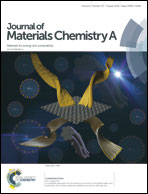Optimization of the pendant chain length in partially fluorinated aromatic anion exchange membranes for alkaline fuel cells†
Abstract
For robust anion exchange membranes, we have investigated the effect of aliphatic side chains on the properties of partially fluorinated aromatic copolymers (QPAFs) with ammonium groups. A new series of QPAF membranes with various interstitial aliphatic side chain lengths (QPAF-Cx) where x = 2–6 were successfully synthesized. QPAF-C3 with a propylene side chain and ion exchange capacity (IEC = 1.24 meq. g−1) showed balanced properties with the highest hydroxide ion conductivity (99 mS cm−1 at 80 °C in water) and relatively low water uptake, based on a well-developed phase separated morphology. Moreover, the QPAF-C3 membrane exhibited excellent alkaline stability to maintain high ion conductivity (98% remaining) and high mechanical properties after 1000 h in 1 M KOH at 80 °C. The QPAF-C3 membrane also revealed reasonable stability even in 4 M and 8 M KOH at 80 °C. In fuel cell operation, the QPAF-C3 membrane exhibited a higher power density (224 mW cm−2) than those of our previous QPAF-C1 (138 mW cm−2), QPAF-C1B (167 mW cm−2), and Tokuyama A-201 (122 mW cm−2) membranes. In the durability test for 62 h, QPAF-C3 maintained 69% of its initial voltage with minor structural degradation.



 Please wait while we load your content...
Please wait while we load your content...
